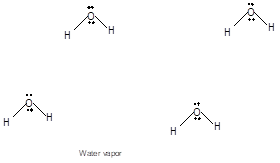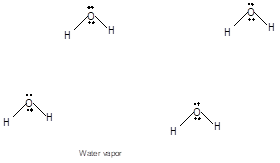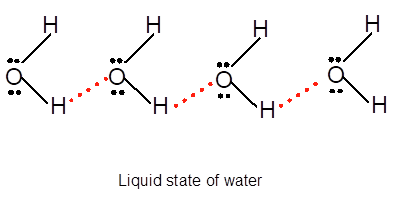
Interpretation: Comprehend the molecular view of carbon dioxide gas.
Concept Introduction: The chemical compounds can be classified as covalent compound and ionic compound. Ionic compounds have complete negative and positive charges on it whereas covalent compounds are formed by equal sharing of electrons between bonded atoms.
The molecular view of any molecule represents the atoms bonded in a molecule with
Answer to Problem 6E



Explanation of Solution
Freezing is the interconversion of liquid state to solid state. When water freezes, the water molecules come close to each other therefore the volume decreases. During freezing of water molecules, water molecules come close to each other but close to freezing point, water molecules arranged in a cage like structure with the help of formation of hydrogen bonds with each other therefore it shows expansion of molecules. Ice is less dense than water due to movement of water molecules slightly apart compared to liquid water. In water vapor molecules are very far from each other as there is no more hydrogen bond between water molecules.



Chapter U3 Solutions
Living By Chemistry: First Edition Textbook
Additional Science Textbook Solutions
Organic Chemistry (8th Edition)
Chemistry: A Molecular Approach (4th Edition)
Introductory Chemistry (6th Edition)
General, Organic, and Biological Chemistry (3rd Edition)
Chemistry
Essential Organic Chemistry (3rd Edition)
 ChemistryChemistryISBN:9781305957404Author:Steven S. Zumdahl, Susan A. Zumdahl, Donald J. DeCostePublisher:Cengage Learning
ChemistryChemistryISBN:9781305957404Author:Steven S. Zumdahl, Susan A. Zumdahl, Donald J. DeCostePublisher:Cengage Learning ChemistryChemistryISBN:9781259911156Author:Raymond Chang Dr., Jason Overby ProfessorPublisher:McGraw-Hill Education
ChemistryChemistryISBN:9781259911156Author:Raymond Chang Dr., Jason Overby ProfessorPublisher:McGraw-Hill Education Principles of Instrumental AnalysisChemistryISBN:9781305577213Author:Douglas A. Skoog, F. James Holler, Stanley R. CrouchPublisher:Cengage Learning
Principles of Instrumental AnalysisChemistryISBN:9781305577213Author:Douglas A. Skoog, F. James Holler, Stanley R. CrouchPublisher:Cengage Learning Organic ChemistryChemistryISBN:9780078021558Author:Janice Gorzynski Smith Dr.Publisher:McGraw-Hill Education
Organic ChemistryChemistryISBN:9780078021558Author:Janice Gorzynski Smith Dr.Publisher:McGraw-Hill Education Chemistry: Principles and ReactionsChemistryISBN:9781305079373Author:William L. Masterton, Cecile N. HurleyPublisher:Cengage Learning
Chemistry: Principles and ReactionsChemistryISBN:9781305079373Author:William L. Masterton, Cecile N. HurleyPublisher:Cengage Learning Elementary Principles of Chemical Processes, Bind...ChemistryISBN:9781118431221Author:Richard M. Felder, Ronald W. Rousseau, Lisa G. BullardPublisher:WILEY
Elementary Principles of Chemical Processes, Bind...ChemistryISBN:9781118431221Author:Richard M. Felder, Ronald W. Rousseau, Lisa G. BullardPublisher:WILEY





